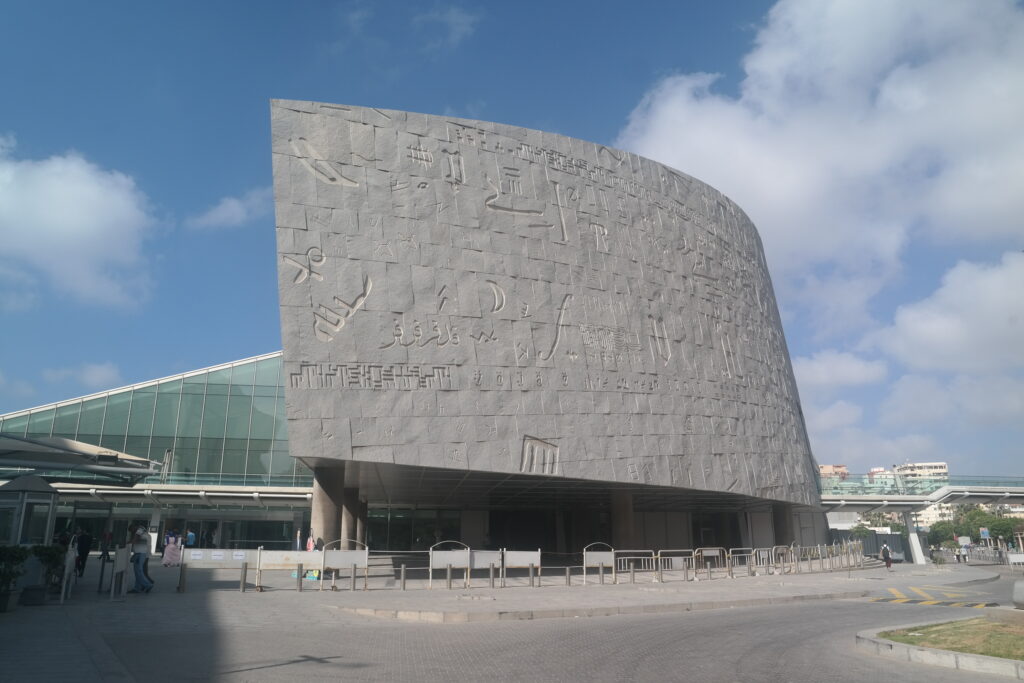Bibliothek von Alexandria:

Eine der größten und berühmtesten Bibliotheken der Antike und Neuzeit
In der Antike war Alexandria berühmt für seinen Leuchtturm, das Grab Alexanders des Großen und die Bibliothek von Alexandria, die vermutlich im 3. Jahrhundert v. Chr. erbaut wurde und zu einem Zentrum der Bildung, Wissenschaft und Kultur wurde. Sie enthielt vermutlich zwischen 400.000 und 700.000 Manuskripte, Bände und Papyrusrollen aus verschiedenen Bereichen. Dazu gehörten Texte in Hieroglyphen, antiker Keilschrift, griechischer Schrift sowie Werke antiker Philosophen und Wissenschaftler wie Archimedes, Euklid, Homer und Aristoteles.
Die Bibliothek wurde 48 v. Chr. während der Herrschaft Julius Cäsars inmitten eines Bürgerkriegs niedergebrannt und zwischen 270 und 275 n. Chr. vollständig zerstört.
The modern library stands at the same location as the ancient one. It was opened in 2002 with a unique design and is a major attraction for tourism and culture in Egypt. The building is designed to resemble the sun rising out of the water’s surface, featuring a slanting cylindrical shape with a massive circular wall inscribed with approximately 6,300 letters, words, and symbols from various ancient and modern world civilizations.
Die Bibliothekssäle bieten Platz für rund 8 Millionen Bücher, verteilt auf neun Ebenen (ca. zehn Stockwerke) mit etwa 90 Säulen. Dank der einzigartigen Bauweise gelangt das natürliche Licht indirekt in die Lesesäle und sorgt so für eine angenehme Beleuchtung.
Die Bibliothek umfasst sechs Fachbibliotheken mit den Schwerpunkten Kunst und Multimedia, darunter die Taha Hussein-Bibliothek für Sehbehinderte, eine Kinderbibliothek, die Al-Nashq-Bibliothek und -Archive, eine Abteilung für seltene Bücher sowie Studienzentren für Kalligrafie, Manuskripte, Zivilisations- und Islamwissenschaften und das Alexandria Center for Hellenistic Studies.
Darüber hinaus umfasst die Bibliothek vier Museen:
-
Das Antiquities Museum, eines der wenigen Museen weltweit, das Artefakte ausstellt, die am Standort der Bibliothek gefunden wurden,
-
Ein Manuskriptmuseum,
-
Ein Sadat-Museum,
-
A Museum of the History of Science.
Außerdem gibt es ein wissenschaftliches Planetariumszentrum, eine Forschungshalle für naturwissenschaftliche Bildung für Kinder, ein Kunstzentrum mit etwa 17 Dauerausstellungen und ein Konferenzzentrum.
Die Bibliothek von Alexandria ist heute ein Symbol für Wissen, Kultur und wissenschaftliche Forschung und verbindet das reiche Erbe der Antike mit dem modernen akademischen und kulturellen Leben.
Der Bibliothek von Alexandria in Egypt is one of the most iconic symbols of human knowledge and ancient civilization. Originally established in the 3rd century BCE, it was once the largest and most significant library of the ancient world. In 2025, the modern Bibliotheca Alexandrina continues this legacy by offering a space that celebrates education, science, culture, and global dialogue.
Inhaltsverzeichnis
UmschaltenA Legacy of Knowledge
The ancient Bibliothek von Alexandria was founded during the reign of Ptolemy I or Ptolemy II and aimed to collect every written work in existence. Scholars from around the Mediterranean came to study philosophy, astronomy, mathematics, and medicine. Although the original library was lost in antiquity—likely due to a series of fires and political conflicts—its spirit lives on through the modern reconstruction.
Der modern Library of Alexandria, opened in 2002, revives the vision of a universal center for learning. It is home to millions of books, digital resources, rare manuscripts, and art exhibitions. As of 2025, it continues to evolve with new technologies and global partnerships.
Iconic Architecture
The architecture of the Bibliotheca Alexandrina is as breathtaking as its mission. Designed by the Norwegian firm Snøhetta, the library resembles a massive sun disc rising from the Earth. Its granite outer wall is engraved with characters from over 120 scripts, symbolizing global knowledge and diversity.
Inside, the building spans eleven levels with open reading spaces bathed in natural light. In 2025, it remains one of Egypt’s most visited architectural landmarks and a hub for educational tourism in Alexandria.
Why Visit in 2025?
With Egypt experiencing a surge in cultural tourism, 2025 is the perfect year to visit the Library of Alexandria. The library regularly hosts international exhibitions, academic conferences, and public lectures that attract scholars and travelers alike.
Whether you’re a history enthusiast, architecture lover, or curious traveler, a visit to the Library of Alexandria offers a chance to connect with one of humanity’s oldest intellectual legacies.
Abschluss
Der Library of Alexandria in 2025 is more than just a building—it is a bridge between the ancient and modern worlds. Its rich history, inspiring architecture, and continued educational mission make it a must-visit destination for anyone exploring Egypt’s cultural treasures.
